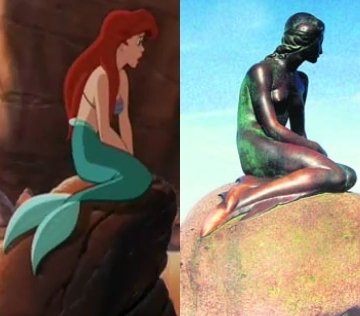 |
| Edvard Eriksen (1876-1959) |
My first artist could easily be considered a one-hit-wonder in that most of his work doesn't get much notoriety. However, one of his pieces has been labeled an official national landmark of Denmark. I am referring to Danish sculptor Edvard Erikson.
 |
| The Hope 1904 |
Falling very much into the style of Classicism, Eriksen actually was one of the first artists to popularize the use of a poetic title to convey the story and emotions of his work. One such example is of a young woman affectionately clutching her child simply entitled "The Hope", bought by the State Museum of Art in 1904.
 |
| The Statue of the Little Mermaid 1913 |
Despite this artist's obscurity, one particular sculpture, "The Little Mermaid", in Copenhagen remains recognized all over the world.
First off, this sculpture moves me with its utter serenity. Unlike many sculptures involving living subjects she isn't caught in the middle of a sudden, unfinished action. And while other more classical pieces are in a dignified but unnatural pose, she is sitting in a manner that looks like it's not only comfortable but that she could be there for a lengthy span of time without moving.
But the one thing that is truly unique about this sculpture, and that I've never seen before, is that the subject is engaged with her real-life surroundings. An inanimate object is reacting to the living shore below her. Most 3-dimensional classical artwork is disconnected from the real world, contained in it's own little bubble only occasionally breaching the fourth wall by potentially staring at the viewer (depending on where the viewer stands in relation to the artwork). If a subject has no known context and its environment doesn't support a story, the character's thought process is entirely speculative. Here, we don't need to know the title or story to understand the relationship between a mermaid and the sea.
However, should you be familiar with the story of Hans Christian Anderson's story of "
The Little Mermaid", the emotional implications of this sculpture are even more potent. This is the moment she is contemplating whether to leave the sea, her home, and risk everything to be with a man. As an audience, we know that she will never return alive.
 |
The Recollection 1915, The Grief 1914, The Love 1917
At King Christian's and his wife Louise's IX Sarcophagus |
But if anything, the driving emotion that seemed to have influenced Edvard Erikson the most was love. His works and their titles (i.e.
The First Grief, The Recollection, The Hope, The Judgement) all seem to stem from it. And indeed Eriksen apparently had a wonderful love life with his beloved wife Eline who stood in as the model for all his female nudes. Perhaps she was the only one who'd undress for him...or perhaps it was because in his eyes, she was the epitome of beauty, his muse.
One can only hope to find such a powerful source of inspiration.
 |
| The Judgement 1905 |
 |
| Ariel vs. Little Mermaid Sculpture |









No comments:
Post a Comment